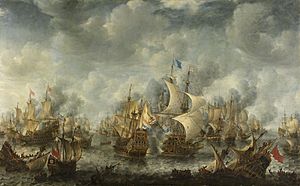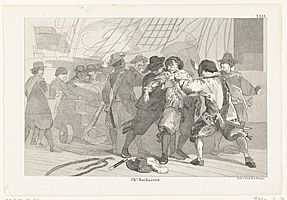Battle of Scheveningen facts for kids
Quick facts for kids Battle of Scheveningen |
|||||||
|---|---|---|---|---|---|---|---|
| Part of the First Anglo-Dutch War | |||||||
 The Battle of Scheveningen, 10 August 1653, Jan Abrahamsz Beerstraaten |
|||||||
|
|||||||
| Belligerents | |||||||
| Commanders and leaders | |||||||
| Strength | |||||||
| 120 warships | 127 warships | ||||||
| Casualties and losses | |||||||
| 950-1,200 killed and wounded 2 warships sunk |
2,000 killed and wounded 12–30 warships sunk |
||||||
The Battle of Scheveningen was the last big naval battle of the First Anglo-Dutch War. It happened on July 31, 1653, between the navies of England and the Dutch Republic. The Dutch navy lost many ships and sailors. But they reached their main goal: they broke the English blockade of their coast.
Contents
Why Did the Battle Happen?
After winning a battle in June 1653, the English navy blocked the Dutch coast. This English fleet had 120 ships. It was led by George Monck on his ship, the Resolution.
Dutch Economy in Trouble
The blockade stopped Dutch merchant ships. This caused big problems for the Dutch economy. Many people lost their jobs. The country faced a serious economic crisis.
Dutch Plan to Break the Blockade
On July 24, the Dutch Admiral Maarten Tromp set sail. He had 100 ships on his flagship Brederode. His mission was to free another Dutch fleet. This fleet of 27 ships was stuck near Texel island. It was blocked by the English.
Tromp's Smart Move
Five days later, the English spotted Tromp. They chased him south. Two Dutch ships were sunk before dark. But Tromp used a clever trick. He moved his fleet north of the English. This allowed the trapped Dutch ships to join him. They met near Scheveningen, close to a village called Ter Heijde.
What Happened During the Battle?
The weather was very bad on July 30. Strong winds blew all night. This made both navies wait.
The Dutch Attack
Around 7:00 AM on July 31, the Dutch attacked. They had the wind on their side. Tromp's ship, Brederode, led the way. The two fleets sailed past each other four times, fighting hard.
Tromp's Death and Dutch Retreat
Early in the battle, Admiral Tromp was killed. A sharpshooter on an English ship shot him. His death was kept a secret. This was to keep the Dutch sailors fighting. But by late afternoon, the Dutch were losing. Twelve of their ships were sunk or captured. Many others were too damaged to fight.
Finally, the Dutch sailors lost hope. Many ships, led by merchant captains, ran away. They sailed north. Another Dutch admiral, Witte de With, tried to stop them. But he could only cover their escape. The Dutch ships retreated to Texel island.
English Victory, But at a Cost
The English navy won the battle. But their ships were also badly damaged. Many sailors were wounded. The English had to return to port for repairs. They could not keep up the blockade.
What Happened After the Battle?
Both sides said they won. The English won the fight itself. The Dutch achieved their main goal. They broke the blockade.
Tromp's Impact and Peace Talks
Tromp's death was a huge loss for the Dutch. Many felt they could not beat England anymore. A political group called the Orangists lost power. Johan de Witt, a key Dutch leader, agreed to a deal. He promised Oliver Cromwell that William III of Orange would never become a powerful leader. This meant the Netherlands would not help bring back the English royal family.
Peace talks began seriously after this. They led to the Treaty of Westminster in 1654. This treaty officially ended the First Anglo-Dutch War. The damage to the Dutch navy in this battle effectively ended the war.



